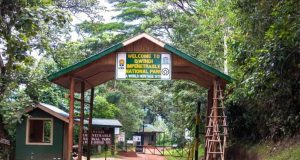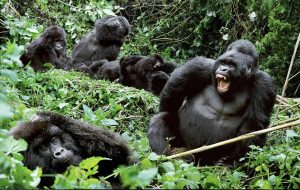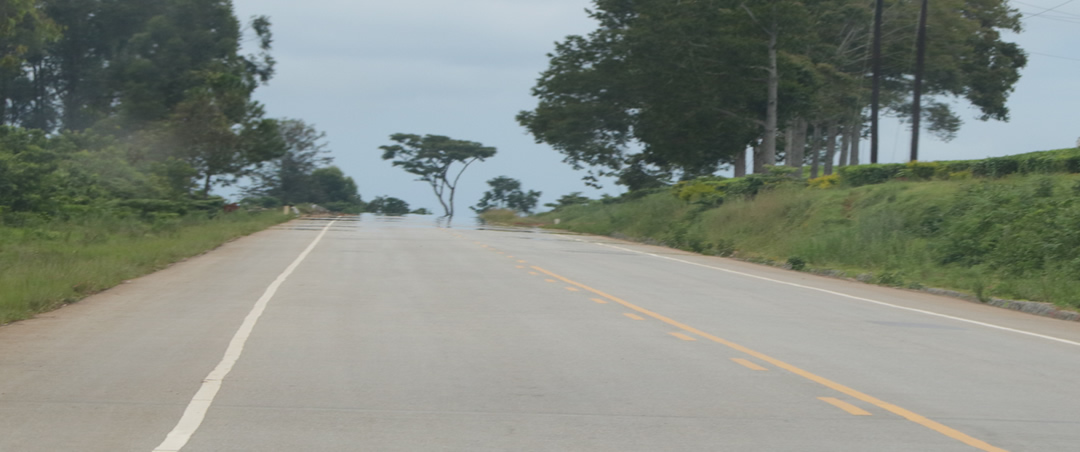Bwindi Gorilla Forest Reserve was established in 1942, later becoming the Bwindi Impenetrable National Park in 1992, and earning recognition as a World Heritage Site in 1994. Spanning 327 km², Bwindi is a dense, ancient rainforest characterized by steep, slippery valleys and high, windy ridges. Despite the challenging terrain, trekking through this forest in search of the endangered Mountain Gorillas is one of the world’s top wildlife experiences.

Entrance to Bwindi Impenetrable Forest
The Climate in Bwindi Forest can be quite chilly, especially in the mornings and at night, with annual temperatures ranging from 7°C to 20°C. The coldest months are June and July, so warm clothing is essential. Additionally, Bwindi Forest receives up to 2390 mm of rain annually, mainly during two wet seasons: the short rains from March to May and the heavy rains from September to November. Unlike typical tropical rainfall, Bwindi often experiences long hours of gentle drizzle, making wet-weather gear necessary.
Bwindi Impenetrable Forest stands as a remarkable testament to time, with its dense, ancient vegetation stretching back over 25,000 years. In contrast, many of the world’s forests are barely 12,000 years old. Over millennia, Bwindi has nurtured an astonishing variety of life, evolving into a biodiversity hotspot teeming with an extraordinary array of species. Within its thick canopy, more than 310 butterfly species flutter among the towering trees, which number over 200 distinct types. The forest is home to 51 species of reptiles and an impressive 88 species of moths, adding to the region’s rich ecological tapestry.
Perhaps most captivating is its mammalian diversity, boasting 120 species, including 10 primates. These include the playful chimpanzees, intelligent baboons, and the strikingly colored L’Hoest’s, red-tailed, and blue monkeys. The black-and-white colobus further enriches the primate population, but none are more iconic than Bwindi’s most famous inhabitants—the critically endangered mountain gorillas. These majestic creatures roam its misty undergrowth, representing life’s fragility and resilience in one of Africa’s most spectacular forests. Bwindi’s ecosystem is a living archive, protecting species that have thrived here for thousands of years.
Gorilla Trekking in Bwindi Forest National Park

Mountain Gorilla Family in Bwindi Forest National Park
Gorilla trekking stands as the main tourist activity done in Bwindi Impenetrable National Park, attracting thousands of visitors from different corners of the world. This remarkable park harbors nearly half of the world’s remaining mountain gorillas in their natural habitat. Currently, there are several habituated gorilla families, carefully monitored and accessible to tourists under strict guidelines designed to minimize disruption and ensure the gorillas’ well-being.
The trek itself is an adventure, traversing varied terrain—lush vegetation, steep inclines, and muddy paths. Experienced Ranger guides lead each group, providing invaluable knowledge about the gorillas, their behavior, and the delicate ecosystem they inhabit. Encountering these magnificent animals in their natural environment is an unforgettable and humbling experience. The opportunity to observe their social interactions, their playful antics, and their sheer power is a privilege that leaves a lasting impression.
Remember to respect the gorillas’ space and follow the park’s regulations to ensure the preservation of this incredible habitat for generations to come. Before going on your gorilla safari to Bwindi Forest, it is highly recommended to be in good physical condition and to bring appropriate clothing and footwear suitable for the challenging terrain. Booking your trek in advance is also essential, as permits are limited to protect the gorillas from overcrowding.
Habituated Gorilla Families in Bwindi Forest National Park
The Mubare Group Family
This is the oldest gorilla family in Bwindi Forest. It was discovered and habituated in 1991 and opened for tourism in 1993. It’s found in the Buhoma Sector and currently consists of 9 members with 1 silverback called Kanyonyi.
The Habinyanja Gorilla Group
This gorilla group is found in the Bohoma sector, was discovered and habituated in 1997, and the first tourists to visit them came in 1999. Currently, this consists of 18 members, including two silverbacks.
The Rushegura Gorilla Group
This Gorilla group is found in the Buhoma Sector, was habituated in 2000, and opened for tourists in 2002. The group currently consists of 19 members, including one silverback.
The Nkuringo Gorilla Group
This gorilla group opened to tourism in 2004. This habituated gorilla group currently consists of about 20 mountain gorillas, including one male silverback leading his family through the lush forests of Bwindi. Witnessing their interactions offers an unforgettable wildlife experience.
The Nshongi Gorilla Group
The Nshongi Gorilla Group was officially opened for tourism in September 2009. This remarkable gorilla family currently consists of 36 individuals, including three dominant silverbacks. Named after the Nshongi River, near where they were first sighted, this group was notable for being one of the largest habituated gorilla families at the time.
Bitukura Gorilla Group
This gorilla group is found in Ruhija sector and was opened for tourism in December 2008 and currently consist of 14 individual.


